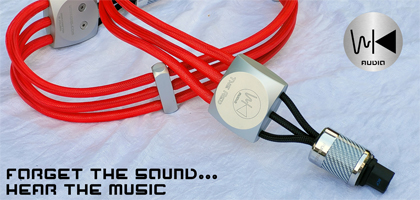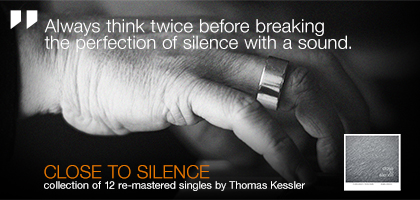No. 248 January 2025
- COVER REVIEW: Gigawatt POWERMASTER 25 ANNIVERSARY EDITION ⸜ AC power conditioner » POLAND
- KRAKOW SONIC SOCIETY № 149: High Fidelity Presents: ART FARMER: Art Farmer in Wrocław » POLAND/Krakow
- REVIEW: Audio Phonique DESIRE SP ⸜ speaker cables » POLAND
- REVIEW: Avatar Audio DREAMLINK № 1 ⸜ analog interconnect • RCA » POLAND
- REVIEW: DS Audio MASTER 3 ⸜ optical cartridge + phono stage » JAPAN
- REVIEW: Laiv HP2A ⸜ preamplifier/headphone amplifier » SINGAPORE
- REVIEW: TiGLON TPL-2000L Professional ⸜ LAN cable » JAPAN
- AWARDS: BEST of… 2024 according to HIGH FIDELITY
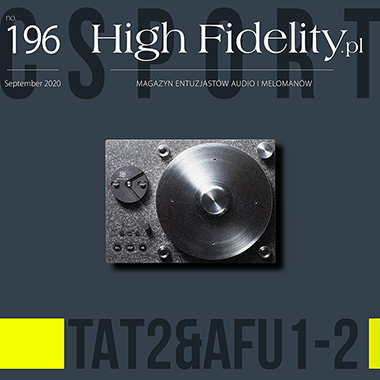
|
Editorial
Text: Wojciech Pacuła | chief editor |
|
No 196 September 1, 2020 |
One reads:  There is no reason why the compact disc has taken this form and not another one. Every aspect, from shape and size to sampling duration and frequency, was the result of random decisions reflecting the specific circumstances of their creation and the people who created them. It could have been invented in a completely different way. " There is no reason why the compact disc has taken this form and not another one. Every aspect, from shape and size to sampling duration and frequency, was the result of random decisions reflecting the specific circumstances of their creation and the people who created them. It could have been invented in a completely different way. "ROBERT BARRY, Compact Disc, „Object Lessons” series, New York 2020, p. 30

⸤ Thinking about the "album" we probably have a vinyl version in front of our eyes - in the photo
AC Records – Two For Two: Reference Acoustique And yet, when we think of a "record", depending on the age of the thinking subject, we either think of a vinyl record, i.e. Long Play, or a compact disc, i.e. Compact Disc. Much less often it will be a cassette tape (Compact Cassette), and quite rarely a digital file, even for the representatives of the youngest generation. I do not know any relevant research, so it is based only on gut feeling, but it seems to me that although most young people would never even reach for any physical carrier of music, stil the term „album” is still associated with a "CD" or an „LP” by them. The "audio file" in the real world does not have a physical "mediator", that is, something that would refer to it. It occurred to me when I took a closer look at the foundations of Aleja Trzech Wieszczów and the Dietlowski Planty, which we now know as Dietla Street. These two, extremely important, arteries have a completely different genesis, and yet they share the same problem - a problem of their form. Aleje Trzech Wieszczów owe their creation to a relatively new history. When Krakow was incorporated into Austria in 1846, it was designated a fortress city. It was surrounded by a network of roads, embankments and forts, as it was an important strategic point in the event of a war with Russia. Due to these limitations - as we read in the monograph Modernizmy. Volume 1. Krakow and the Krakow Voivodeship edited by Andrzej Szczerski - at the beginning of the 20th century it was the most densely populated city in Austria. As a result of a change in the defense concept, the areas freed by the army were bought and transformed by the city. The commission that dealt with it agreed that it was necessary to draw on Western European patterns and announced an urban planning competition. The winning project, says Barbara Zbroja, author of the article Monumental and elegant - Aleje Trzech Wieszczów, published in the aforementioned monograph, alluded to the then-popular concept of the GARDEN-CITY developed by a British urban planner Ebenezer Howard. 
⸤ Józefa Dietla Street, as seen from the intersection with Starowiślna Street. In any case, in place of the leveled railway embankment, Krasiński, Słowacki and Mickiewicz avenues were to be built. Their width was set at 52 meters. Looking today at how they have been developed, the main thing that draws attention is their division into a centrally running, wide green belt and lanes for pedestrians and cars located on the sides, running right next to tenement houses. Importantly, greenery is inaccessible to pedestrians, it only serves to physically - not to say mechanically - separate the lanes. The case of Józef Dietl Street is different. It runs in the place of the Old Vistula bed. From the fourteenth to the sixteenth century, this northern arm of the Vistula was the main stream of the river in the city and it served not only communication but also defense purposes. In the axis of today's Stradomska and Krakowska streets, there was the only permanent bridge in medieval Krakow, known as the Królewski (Royal) bridge. By the way - the bridge, which postponed the renovation of Krakowska Street by over a year. The “discovery” of what was left of it by the workers stopped the works for so long that we stopped counting on the fact that the tram will ever go that way. 
⸤ In the middle of Dietl Street there are green squares, and nowadays tram tracks; view from the intersection with Krakowska street. In any case, the Old Vistula began to disappear in the 17th century. Muddled, contaminated with filth, it became a breeding ground for bacteria, including cholera. Therefore, in 1873, the City Council decided to fill it in, which was successfully completed in 1878–80. Today it is simply a wide, green patch of land (planty), separating two former cities, and today’s districts - Śródmieście (Midtown) and Kazimierz. It features a layout similar to that of Aleja Trzech Wieszczów, i.e. a green belt in the middle and communication routes on the sides. The difference is that here the tram line runs right in the middle. |
And now - the arrangement in question doesn't make sense. It seems to be well-thought-out, but when we drive through there often enough, and more importantly when we walk through there, it turns out that this "natural" form of the avenue is turned upside down. In 2017, Dziennik Polski wrote in its online edition of Dziennikpolski24.pl:

⸤ Visualization of one of the projects developed at the Cracow University of Technology. Fig. Materials of the Cracow University of Technology In the article, the journalist asked people passing by and residents about their vision of the place. Most of the answers attempted to point out ways to improve the existing conditions. People talked about widening the green lanes, narrowing lanes for car traffic, etc. At the same time, something more important is eluding attention - for the change to be significant and to realistically improve this place, one would have to carry out a revolution: switch placed between the greenery and streets. Let's think about it - the sidewalks should be adjacent to the greenery, not the street - the latter should be placed in the middle. This would help to cool down buildings shaded by trees, that now cool the grass, and would also reduce the annoyance of car traffic. The creators of the Dietl Planty tried to respond to this challenge to some extent. There, along the tram tracks, there are wide, shaded alleys with benches. However, if any of you has gone there at least once, you know that the inhabitants do not venture there - the homeless people sleep, sit and party on the benches. The locals sneak on the sides, along the tenement houses, along the paved sidewalks with parked cars. The audio industry does not stand out in this respect - we are also slaves of the form. The aforementioned CD is a good example of this fact. It's just that we do not know any other "digital disc", we have received it already shaped, while most of the choices of audio manufacturers are based on our habits. It is so, that the perfectionist audio industry is extremely conservative. We tell ourselves that we are progressive and that we are only interested in sound quality. In fact, however, we are the "keepers of the past" and in the name of maintaining the status quo we reject many interesting solutions. 
⸤ An absolute classic - the Leben CS300SX amplifier. Its inputs and outputs layout reflects our habits and striving for convenience, not technical requirements | photo: Leben Examples? - Here you go: why in tube amplifiers inputs and outputs are placed on the same side of an amplifier, usually at its the back? It makes no sense - this type of amplifier has an input and output sections and output transformers. The most sensible solution would be to install the inputs at one end and the outputs at the other. The second example - turntables. The vast majority of them look only slightly different from what was established at the beginning of the 20th century - they have a wooden, rectangular housing in which the platter, motor and arm are mounted. And we know that the rectangular shape in this type of device is extremely unfavorable. That is why I am so curious about designs like the Soulines Kubrick DCX, the Rega Planar 8 model, and even the inexpensive RPM-1.3 turntables from Pro-Ject, in which form - still beautiful - follows function. 
"Skeleton" - is the name of the base used by Rega in its most expensive models | photo Rega Nothing, however, beats our attachment to the form of classic devices, such as transistor amplifiers, CD players, etc. Their form, where only the front panel counts, and the rest is nothing more but an uncomfortable auxiliary features that are best hidden, has its origin in the fact that initially (in 1950s and 1960s) they were actually installed in furniture, and later (in 1970s) they were supposed to "pretend" to be devices from a laboratory. They were supposed to be more credible in this way. When a project appears today that deviates from this stereotype, it is received with interest, even recognition, and yet it quickly disappears from the market. As some audio sellers I know told me, people who like to listen to the music are reluctant to choose unusual loudspeaker colors, or to choose devices that look different from what they are used to. For almost always our habits prevail. The dictate of form prevails. WP |
About Us |
We cooperate |
Patrons |
|
Our reviewers regularly contribute to “Enjoy the Music.com”, “Positive-Feedback.com”, “HiFiStatement.net” and “Hi-Fi Choice & Home Cinema. Edycja Polska” . "High Fidelity" is a monthly magazine dedicated to high quality sound. It has been published since May 1st, 2004. Up until October 2008, the magazine was called "High Fidelity OnLine", but since November 2008 it has been registered under the new title. "High Fidelity" is an online magazine, i.e. it is only published on the web. For the last few years it has been published both in Polish and in English. Thanks to our English section, the magazine has now a worldwide reach - statistics show that we have readers from almost every country in the world. Once a year, we prepare a printed edition of one of reviews published online. This unique, limited collector's edition is given to the visitors of the Audio Show in Warsaw, Poland, held in November of each year. For years, "High Fidelity" has been cooperating with other audio magazines, including “Enjoy the Music.com” and “Positive-Feedback.com” in the U.S. and “HiFiStatement.net” in Germany. Our reviews have also been published by “6moons.com”. You can contact any of our contributors by clicking his email address on our CONTACT page. |
 



|
   |
main page | archive | contact | kts
© 2009 HighFidelity, design by PikselStudio,
projektowanie stron www: Indecity



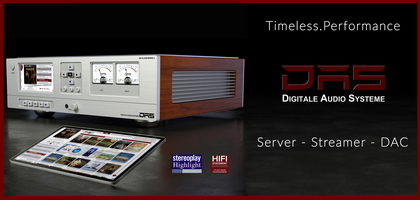

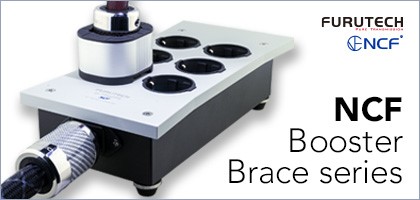

 he author of this excellent compendium of knowledge regarding the CD format immediately afterwards refers to the novel by Walter Tavis, entitled The Man Who Fell to Earth (1963), in which the music carrier of the quadraphonic system (!) were small steel balls, as well as Philip K. Dick's Simulacra released a year later, for whom the a living creature from Ganymede, the largest moon of Jupiter, was an essential component of the Ampek F-a2 recorder.
he author of this excellent compendium of knowledge regarding the CD format immediately afterwards refers to the novel by Walter Tavis, entitled The Man Who Fell to Earth (1963), in which the music carrier of the quadraphonic system (!) were small steel balls, as well as Philip K. Dick's Simulacra released a year later, for whom the a living creature from Ganymede, the largest moon of Jupiter, was an essential component of the Ampek F-a2 recorder. 
